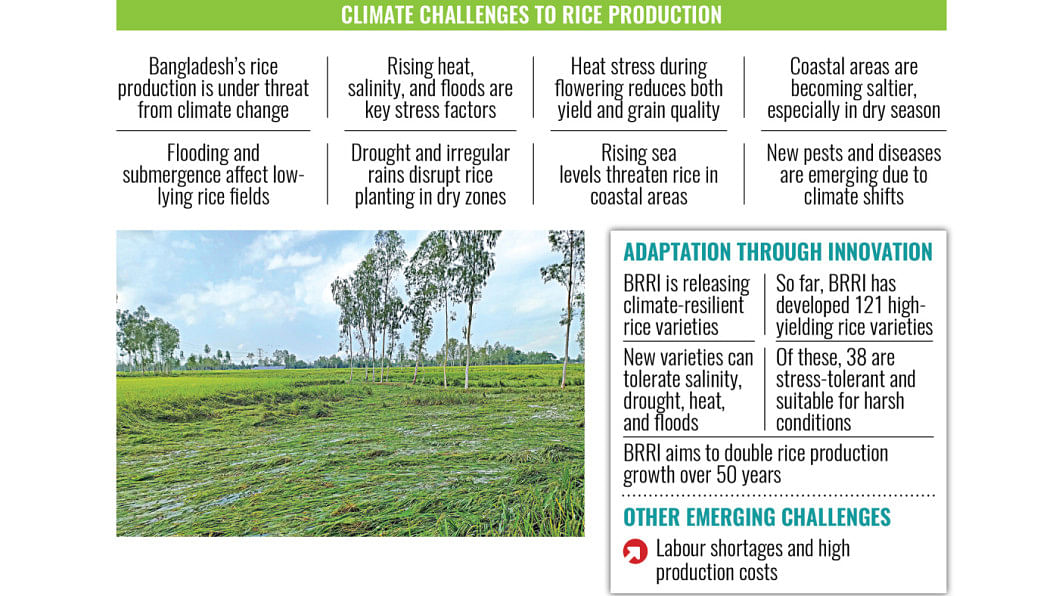Rice production already under climate stresses

Bangladesh is already facing the brunt of climate change in its major rice-growing regions, according to Bangladesh Rice Research Institute (BRRI) Director General Mohammad Khalequzzaman, as the institute has identified several climate-induced stresses that threaten production and eventually cause food security concerns.
"Rising temperatures and heat stress during the flowering and grain-filling stages are reducing both grain quality and yield," said the BRRI chief in an interview with The Daily Star.
He said that coastal areas are experiencing increasing salinity during the dry season, while low-lying regions are frequently affected by flooding and prolonged submergence. Meanwhile, drought and erratic rainfall are disrupting cropping patterns in drought-prone zones.

"Changing weather patterns are also giving rise to new pest and disease pressures, making rice cultivation more difficult," added the agri scientist.
To deal with the issues, Khalequzzaman said BRRI is taking a range of proactive steps.
"We are developing and releasing climate-resilient rice varieties with tolerance to salinity, flooding, drought, and heat. Our goal is to combine multiple stress tolerances using trait pyramiding and modern breeding techniques," said the BRRI DG.
According to him, the institute is also promoting climate-smart technologies, including water-saving methods, improved crop management packages, and greater mechanisation, to increase resilience and reduce climate-related risks.
Besides, the institute is working with both national and international partners to monitor climate trends, model future risks, and guide its breeding strategies.
"These combined efforts are meant to safeguard rice production from climate threats and secure the country's long-term food security," he said.
Khalequzzaman said their long-term target is to maintain rice production growth at more than twice the rate of population growth over the next 50 years and ensure national self-sufficiency.
"To achieve this, we have formulated a long-term strategy focused on high-yielding, climate-resilient, and location-specific rice varieties and technologies," said the BRRI chief. "At present, our breeding programme covers 17 key ecosystems across 25 geographic segments, aligned with 25 product profiles."
He also highlighted BRRI's seed distribution network, which supplies breeder seeds of all major and newly released varieties. "We are committed to delivering full production packages to help farmers maximise yields from these improved varieties," he added.
However, the journey is not without obstacles. Khalequzzaman admitted that developing high-yielding, climate-resilient varieties is a complex task.
"The increasing frequency of droughts, floods, salinity, submergence, and heat stress presents overlapping challenges that are technically difficult and time-consuming to address," he commented.
One of the biggest scientific issues lies in identifying and combining stress-tolerant genes from diverse sources while maintaining high yield potential.
On top of that, limited funding, inadequate infrastructure, and a shortage of skilled personnel slow down the adoption of advanced breeding tools, such as genomic selection and precision phenotyping, according to the scientist.
Overcoming these obstacles, BRRI has so far developed and released 121 high-yielding rice varieties, including 113 inbred and 8 hybrid types. These are suitable for various seasons and agro-ecological zones across the country.
Besides, in response to ecological diversity and increasing climate pressures, the institute has released 35 varieties resistant to abiotic stresses and three resistant to biotic stresses.
Among them, BRRI dhan-67 (salinity-tolerant), BRRI dhan-71 (drought-tolerant), and BRRI dhan-51 and 52 (submergence-tolerant) have performed well. These varieties have been widely adopted in stress-prone areas, increasing production under difficult conditions, said Khalequzzaman.
Recently, BRRI released three more varieties — BRRI dhan-109, BRRI dhan-110, and BRRI dhan-111 — designed for submergence, tidal submergence, and semi-deep water environments.
The BRRI chief said these are expected to expand rice cultivation in challenging areas and increase yields, improving the livelihoods of affected farmers.
With rising sea levels posing a growing threat to coastal agriculture, the DG said BRRI has adopted targeted strategies to sustain cultivation and ensure food security in these vulnerable regions.
These include the development of salinity- and tidal submergence-tolerant varieties, as well as dual-tolerant types. The institute is also promoting short-duration and early-maturing varieties to help farmers avoid peak salinity periods.
"In parallel, BRRI is advancing better water and soil management techniques and conducting integrated research to map out where specific varieties are best suited," he said.
"These solutions are enabling coastal farmers to continue growing rice and protect their livelihoods."
But while many farmers remain committed to rice cultivation, some say it is no longer profitable when all costs are considered. What is BRRI's view on the economics of rice farming?
Khalequzzaman acknowledged that profitability varies widely depending on location, season, input costs, and farm management.
"Rising prices of fertilisers, labour, irrigation, and mechanisation have made rice farming less profitable for some," he said. "Yet rice is the most reliable and culturally important crop for most Bangladeshi farmers," he added.
Several studies by BRRI suggest that improving the rice marketing system and ensuring fair prices would enhance farmer profitability. The institute also collaborates with partners to conduct cost-benefit analyses and develop location-specific production strategies to increase farm-level returns.
"Despite the challenges, we have seen that with the right technologies and better practices, rice farming can still be both economically viable and sustainable," said the DG.
He also mentioned that BRRI has developed 14 premium rice varieties so far, including seven enriched with zinc, four with a low glycaemic index (diabetic-friendly), two rich in antioxidants, and one with GABA (gamma amino butyric acid). These varieties have strong export potential.
On top of this, BRRI has released a Basmati-quality variety (BRRI dhan-104) and a Jasmine-type variety (BRRI dhan-80). Several promising premium lines, including black rice, are also in the pipeline and could soon meet international export standards, Khalequzzaman said.
Apart from climate stresses, he identified some other threats to rice production, such as shrinking agricultural land, water scarcity, soil degradation, labour shortages, pest and disease outbreaks, and unstable markets.
"Addressing these threats will require an integrated approach," he said. "We must combine climate-smart varieties and sustainable practices with strong policy support and a more efficient market system to ensure long-term resilience."
Regarding inadequate research funding and a growing brain drain in agriculture, Khalequzzaman said, "Yes, agricultural research in Bangladesh is underfunded, and we are losing talented researchers to opportunities abroad."
He called for increased and sustained investment to support the development of climate-resilient technologies and respond to emerging threats.
"To retain talent and make progress in rice research and food security, we need investment in infrastructure, competitive incentives, and stronger collaboration," he concluded.

 For all latest news, follow The Daily Star's Google News channel.
For all latest news, follow The Daily Star's Google News channel. 



Comments